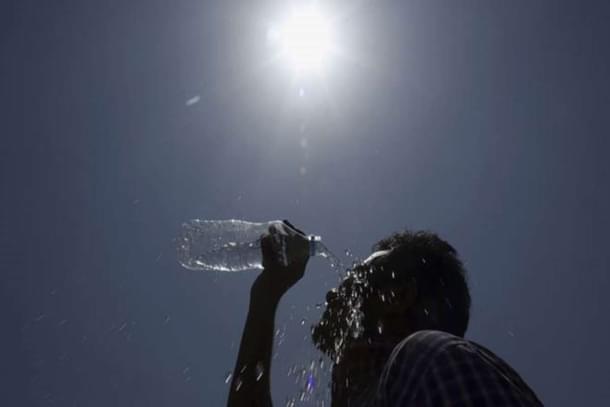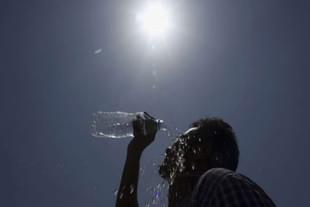Ideas
2022 Is Hotter Than Most Years, But Here's Why Urban India Is Feeling Even Hotter
Arun Kumar Das
May 06, 2022, 06:20 PM | Updated 06:20 PM IST
Save & read from anywhere!
Bookmark stories for easy access on any device or the Swarajya app.


North-western India and central India have been reeling under scorching temperatures since March this year. While India recorded its warmest March in the last 122 years, by April, the hilly regions of the country were also engulfed by a severe heat wave.
In Himachal Pradesh, there were 21 days of heat waves in March-April 2022, with temperatures rising up to an unprecedented 42.5 degree C in Una; in Drass (Ladakh, one of the coldest places in the country) the mercury had gone up to 22.6 degree C.
While exposure to heat waves outdoors can have serious health impacts and can even be fatal, the National Centre for Disease Control has reported 3,775 deaths in 2015-19 due to heat-related illnesses — the effects are also felt indoors.
Extreme heat can lead to thermal discomfort inside buildings which can have adverse health outcomes related to sleep disorders, irregular blood pressure, respiratory and cardiovascular diseases, mental health disorders, and pregnancy-related complications, among others, says housing and health guidelines of the World Health Organization (WHO).
Cities On Fire — The Urban Heat Island Effect
The impact of heat waves is more pronounced in cities due to the Urban Heat Island effect. It is a phenomenon where densely populated and built urban areas witness higher temperatures than their surrounding rural areas.
For instance, according to an assessment, Kolkata can witness increased local urban temperatures anywhere between 1 to 3 degree C more during the day and potentially up to 12 degree C more at night, in comparison to surrounding rural areas.
The Urban Heat Island effect must not be mistaken as a tropical climate issue — it is a very ‘urban issue’ that is linked with the way we plan and design our cities. Even a cold weather city like London has witnessed up to 10 degree C higher temperature in summer nights than its surrounding green belt.
The reason is rampant construction, concretisation and shrinking of green spaces and waterbodies in cities — this is leading to a trapping of heat. Kolkata, for instance, has a mere 0.63 sq m per capita of green spaces, when it should not be less than 12 sq m per capita (according to the WHO’s guidelines).
More Heat Leads To More Energy Use
Other than the public health risk, heat waves are bound to upset the energy budget as they cause a surge in electricity demand due to increased use of air-conditioners. It is of utmost importance to prevent energy lock-in in our new buildings and also retrofit older buildings to withstand the warming environment and reduce energy consumption.
“Such enormous energy guzzling is going to make India miss its target of reducing cooling demand by 25-30 per cent and reducing cooling energy requirements by 20-40 per cent by 2037-38, as demarcated under the India Cooling Action Plan. India needs energy fasting. It needs interventions that reduce energy need in buildings. This can be done through innovations and modifications in design and operations of buildings and the built environment, even as user behaviour would play a major role,” says Rajneesh Sareen, Centre for Science and Environment Programme Director for Sustainable Buildings and Habitat Programme.
What Is Going Wrong In Our Building Sector?
Affordable housing projects fail to comply with the latest energy code: India Cooling Action Plan 2019 merits compliance to Eco Niwas Samhita (ENS) as part of the national thermal comfort strategy. ENS was released in 2018 for energy conservation in residential buildings. A CSE assessment of several affordable housing plans and projects in different climate zones shows that none of them meet the heat gain requirements.
Rampant use of climate-inappropriate building materials and non-compliance to energy codes are a big challenge.
CSE conducted a study on material penetration in multiple cities using the state Real Estate Regulation Authority (RERA) database. The investigation revealed that more than one-third of the projects sampled are using monolithic wall panels made of concrete — this material gets heated up more than twice as fast as a conventional burnt clay brick wall.
States need to take stock of the thermal performance of the ongoing housing projects and develop design and material guidelines to inform future housing stock. These guidelines then need to be integrated with the building by-laws for a wider coverage.
New era of energy codes are neglecting thermally-inclined traditional walling assemblies: as much as 70 per cent of dwelling units sanctioned under the Pradhan Mantri Awas Yojana (Urban) fall in the self-construction category. These self-constructed houses have traditionally used walls with high thermal mass which has kept the indoors of the houses cool.
But today, housing schemes that link fiscal support to pucca structures and energy codes such as ENS are forcing a transition to modern walling technologies. These new technologies revolve around the insulation properties of materials and overlook the thermal massing characteristic of traditional walling assemblies that has helped self-constructed houses to withstand the native climate.
What Is The India Cooling Action Plan?
The India Cooling Action Plan (ICAP) was released in 2019 by the Ministry of Environment, Forest and Climate Change. On the grounds that by 2038 a significant percentage of households in India would be living in thermally uncomfortable buildings due to bad design — and with space cooling demand shooting up consistently — the ICAP set a target of reducing national cooling demand by 25-30 per cent and reducing cooling energy requirements by 20-40 per cent by 2037-38.
ICAP brings multi-sectoral strategies to provide thermal comfort for all, such as promotion of low-energy cooling technologies, implementation of building energy conservation codes, increasing efficiency of cooling appliances, and integrating thermal comfort in affordable housing, among others.
Arun Kumar Das is a senior journalist covering railways. He can be contacted at akdas2005@gmail.com.




